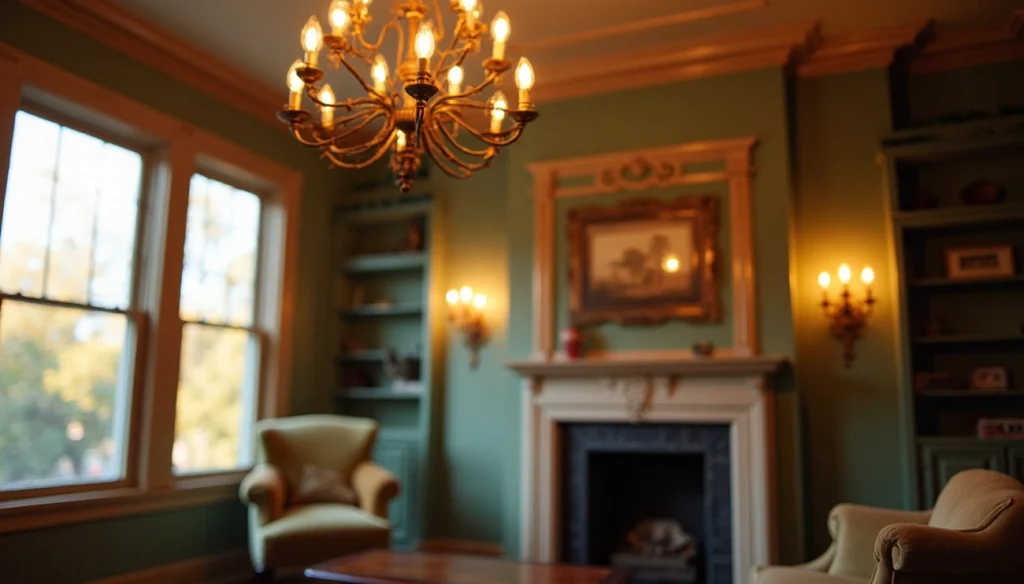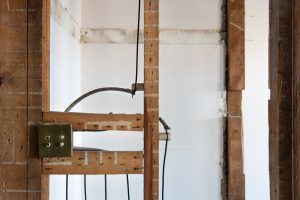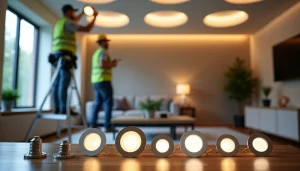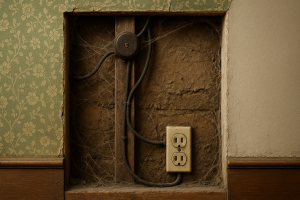Looking for lighting ideas for older homes? Many homeowners face this challenge. Older homes lack proper lighting design plans and their smaller, boxed-in spaces create unique illumination challenges.
La Verne’s historic houses built between 1880 and 1930 deserve lighting that improves their character and meets modern needs. Simple fixture installations won’t solve the lighting issues in old houses. Your older home might need electrical panel updates to handle the increased amperage from computers, HVAC systems, and modern appliances. Affordable options like window treatments can complement your lighting strategy and boost energy efficiency.
This piece walks you through 15 expert-approved solutions that respect your home’s history while bringing it into the 21st century. These ideas work great whether you want safety lighting for older adults or kitchen lighting solutions for older homes. Let’s add brightness to those vintage spaces without emptying your wallet or sacrificing style!
Restore Original Fixtures with Modern Wiring
Your La Verne home’s beautiful original light fixtures tell a story that goes beyond mere decoration. These vintage treasures deserve preservation through careful restoration and modern rewiring.
Why original fixtures matter
Modern reproductions can’t match the authentic character of original fixtures. Each piece showcases the craftsmanship and design esthetics from earlier eras that give us a glimpse into your home’s past. You can spot genuine antique fixtures by their patina, wear patterns, and period-specific manufacturing techniques. These elements maintain your home’s historical integrity and might even boost its value.
Restoration allows you to:
- Preserve your La Verne home’s architectural heritage
- Enjoy unique lighting that matches your home’s original style
- Create a meaningful conversation piece with historical significance
How to rewire safely
Safety should be your top priority when restoring vintage fixtures, since lighting circuits installed before 1966 typically lacked proper grounding.
First steps:
- Turn off power at the circuit breaker before touching any fixture
- Use a voltage tester to check for live wires
- Take photos while you carefully disassemble the fixture
DIY enthusiasts who know simple electrical work might handle basic fixture rewiring. All the same, complex fixtures need professional help, especially those with multiple switches or major repairs.
Note that new electrical work must meet current building codes without affecting your existing installation. Antique fixtures need complete refurbishment with reinforced insulated components that meet modern safety standards.
Where to find restoration experts
The right restoration specialist can preserve your fixture’s historical value perfectly. Professional restorers provide:
- Cleaning and repair of damaged components
- Safe rewiring that meets current electrical codes
- Restoration of original finishes and patina
Look for specialists who know historic lighting and La Verne’s architectural styles. Several companies now provide period-appropriate light fixtures and restoration services that suit late 19th and early 20th century homes.
Check examples of previous work with fixtures like yours before choosing a restoration expert. A qualified professional understands both the esthetic appeal and functional needs of vintage lighting.
Use Chandeliers to Add Vintage Elegance
A well-chosen chandelier speaks volumes about vintage elegance. These statement pieces will lift any room in your older La Verne home and create a focal point that draws your eyes upward.
Chandelier styles for old homes
Your home’s architectural period plays a big role in picking the right chandelier style:
- Crystal chandeliers add timeless luxury to formal spaces. Their cut glass catches light and creates a warm atmosphere that works beautifully in traditional settings.
- Antique brass chandeliers bring golden warmth and glamor to intimate spaces like bedrooms.
- Art Deco chandeliers with bold geometric patterns complement homes from the 1920s-30s.
- Victorian chandeliers showcase extravagant design with glass, crystal, or beaded elements arranged around a central column.
The “tent and bag” Regency chandelier or a Georgian crystal design with its distinctive blue-gray tint can give you an authentic period look. On top of that, Tiffany-inspired fixtures with stained glass elements are a great way to add artistic flair to Arts and Crafts or Art Nouveau homes.
Best rooms for chandeliers
Chandeliers shine particularly well in these spaces:
- Dining rooms (placed 30 inches above the table surface)
- Entryways and foyers
- Living rooms as dramatic focal points
- Master bedrooms for added elegance
High-ceilinged homes make ideal settings for chandeliers as they fill vertical space beautifully. Homes with lower ceilings (common in older construction) need fixtures that won’t hang too low—they should clear doors and keep spaces from feeling crowded.
Installation and ceiling support tips
Safe installation of a vintage chandelier depends on several key factors:
The right size matters—add your room’s length and width in feet to find the ideal chandelier width in inches. Height calculations need your ceiling height multiplied by 2.5-3 inches.
Heavy chandeliers (over 35kg) need extra ceiling support. You might need to:
- Install a reinforced electrical box
- Add blocking between ceiling joists
- Use proper mounting hardware rated for the fixture’s weight
Antique fixtures should have their wiring checked by a professional electrician to ensure compatibility with modern electrical systems. This step is a vital safety and functionality requirement in older La Verne homes.
Install Motion Sensor Lights for Safety
Motion sensor lighting creates a perfect blend of safety and esthetics in older homes. These practical upgrades make life easier and help prevent accidents in your vintage La Verne residence.
Why motion sensors help older adults
Statistics show all but one of these seniors experience a fall each year. Motion sensor lights automatically light up dark areas when they detect movement. This reduces fall risks by a lot because pathways stay visible.
Automatic lighting makes nighttime movement safer. The lights turn on instantly during late-night bathroom or kitchen trips instead of searching for switches in the dark. This simple addition lets older adults stay independent and gives them peace of mind.
The National Council on Aging’s survey showed that 80% of seniors felt more secure after they installed motion-activated lighting systems. These lights are budget-friendly since they turn on only when needed rather than staying on all the time.
Where to install them
The right placement will give a better performance. The best spots for motion sensors are:
- Hallways connecting bedrooms to bathrooms
- Stairways and entryways
- Outside near doors and walkways
- Garages and utility areas
Exterior sensors work best when mounted 8-10 feet above ground. They should face areas with frequent movement, like pathways or gardens. The sensors should have a clear view without trees or building features blocking them.
The transition areas between rooms need special attention inside your home. This technology works great in bathrooms, closets, and beside beds.
Best types for historic homes
La Verne’s vintage homes need fixtures that match their architectural style. Many companies now make motion sensors that work with existing antique fixtures. This lets you keep your original lighting while adding modern features.
Dual-technology sensors combine different detection methods and are a great choice. These advanced options reduce false triggers but still turn on when needed.
The cost depends on how complex the installation is, though many simple motion sensor fixtures are DIY-friendly. Older homes with original wiring need a professional electrician’s help to integrate properly with the historic electrical system.
Use LED Edison Bulbs for a Classic Look
Want to add period-appropriate lighting to your historic La Verne home? LED Edison bulbs blend vintage charm with modern efficiency, and homeowners of older properties love them more each day.
What are LED Edison bulbs
LED Edison bulbs give Thomas Edison’s original design a modern twist. These versions pack energy-efficient LED technology while keeping that classic vintage look. The real magic comes from their visible filament design – you’ll see charming squiggly or straight filament patterns that create a warm, nostalgic glow.
You can pick from globe, straight tubular (ST19), and teardrop styles. The bulbs come with clear glass for that classic look, amber tones for a candlelit feel, or smoke finish for something more contemporary. Best of all, they fit standard medium E26 bases, so they’ll work with the fixtures you already have.
Why they work well in old houses
Your older home will benefit from LED Edison bulbs in many ways. These bulbs use 80% less energy than their traditional counterparts. The savings add up fast – a 60W equivalent LED Edison bulb costs just $1.06 per year to run if you use it 3 hours each day.
These bulbs last much longer too. You’ll get about 15,000 hours compared to just 3,000 hours from incandescent Edison bulbs. This makes a big difference in older La Verne homes where changing bulbs can be tricky.
The color temperature options let you match your home’s style perfectly. You can choose from very warm 2200K that looks just like antique bulbs, all the way to brighter 3000K. These bulbs look great in:
- Kitchen islands with pendant lights
- Dining rooms that need that cozy feel
- Bathroom vanities for a touch of vintage Hollywood
- Bedside lamps where soft light matters
Where to buy them locally
You won’t have trouble finding LED Edison bulbs in La Verne. Home Depot stocks several options, including Feit Electric’s 60-watt equivalent ST19 dimmable vintage LED bulbs with clear glass and straight filaments. Ace Hardware’s shelves are stocked with LED Edison bulbs, filament bulbs, and other antique-style lighting options.
Before you buy, check the brightness (in lumens), whether they dim, and the base size. A typical 60-watt equivalent LED Edison bulb gives you 800 lumens while using just 4-8 watts of power.
Add Stairway Lighting for Safety and Style
Stair lighting in your historic La Verne home can do more than just prevent accidents. A well-lit staircase not only keeps everyone safe but also adds character to your home’s design.
Why stair lighting is essential
Stair accidents happen frequently and can lead to serious injuries. The risk gets higher as people age. Each year, stair-related accidents injure, hospitalize, or kill more than a million people. Good staircase lighting affects visibility directly, making it vital for safety rather than just decoration.
Proper stair lighting becomes even more important for elderly residents and people with poor eyesight. Adding contrast strips to stair edges along with good lighting can reduce falls by a lot. Night navigation becomes safer without fumbling for switches in the dark. A National Council on Aging survey shows that 80% of seniors felt more secure after getting these systems installed.
Types of stair lighting
Your older home can benefit from several lighting options:
- Recessed lights in stair risers give off a soft glow to light each step while staying hidden when off
- LED strip lighting beneath treads creates a floating look that’s both safe and stylish
- Wall-mounted fixtures placed 5-7 feet high light your way without causing glare
- Handrail lighting builds light right into the rails to mix function with style
Hidden light sources under each tread work great for open riser staircases. They cast nice shadows while giving off the light you need. You might also like pendant lights hanging through the middle of your staircase to spread light everywhere.
How to install in older homes
Light placement makes all the difference in historic La Verne homes. Your stair lights should sit 200-300mm above the tread to give a warm glow without glare. Space them evenly – lighting every second or third step works well and looks classic.
LED strip lights with sticky backs are great for DIY projects. All the same, older homes often need a professional’s touch because of complex wiring issues. Homes built around 1900 often have carpeted stairs, so recessed can lights in sloped ceilings or puck lights along step sides might be your best bet.
The whole project might seem challenging at first, but boosted safety and better looks make stair lighting worth every penny in your vintage home.
Use Track Lighting in Converted Attics or Basements
Older La Verne homes with converted attics and basements face unique challenges with lighting. Track lighting systems give homeowners the perfect solution for these transformed spaces that fixed fixtures can’t match.
Why track lighting is flexible
Track lighting’s versatility makes it stand out from other options. The system lets you adjust both light direction and focus, which makes it perfect to highlight workstations or storage zones. You can easily alter or extend these systems as your needs change, unlike fixed fixtures.
Track lighting saves valuable floor and wall space – a crucial benefit in converted rooms with tight dimensions. It also lets you redirect lights when you move furniture without replacing the fixtures.
Best uses in older homes
Track lighting lights up sloped ceilings and hard-to-reach corners in converted attics where standard fixtures fall short. These systems really shine in basement entertainment areas when you need to light up:
- Family photos, artwork, or collectibles
- Game tables, dartboards, or scoreboards
- Reading nooks or study areas
The system creates perfect ambient light throughout basement spaces while adding accent lighting to architectural features. You’ll find styles that match your older home’s character since these systems come in many designs.
Installation tips
The cost runs between $100-$300 if your room has overhead lighting already. New wiring and junction boxes add another $100-$200 if you don’t have existing fixtures.
Homes built before 1980 need special attention – older wiring might only be rated to 60°C. GFCI breakers should be your choice for safety in century-old homes with two-wire systems that lack ground conductors.
Your installation plan should include:
- A floating-canopy connector with a junction box to power along the track’s length
- A live-end connector with a junction box if you need power at the end
- Cord-and-plug connectors that work with standard outlets
A qualified electrician who knows historic homes should review your plans to ensure safe integration with the existing electrical system.
Install Vanity Lighting in Vintage Bathrooms
Vintage La Verne homes’ bathrooms present amazing opportunities to create lighting that works well and stays true to their historical character. The perfect vanity lighting can turn these spaces into practical grooming areas while highlighting their unique charm.
Vanity lighting ideas for old homes
Vintage-style sconces placed on both sides of the mirror give you the most flattering, shadow-free light you need for daily grooming. Schoolhouse fixtures with milk glass shades or Art Deco-inspired sconces with porcelain fitters add authentic period appeal. You might also love lantern or cage-style fixtures that bring rustic industrial character and create interesting shadow patterns.
How to blend old and new styles
The right balance comes from smart mixing. Shaded sconces with simple, clean bases work beautifully with modern faucets. Your fixture heights should match your ceiling height to avoid a cramped look. A mix of metal finishes like chrome, brass, and bronze adds visual depth to your bathroom. You can create a curated look by picking fixtures that weren’t made just for bathrooms.
Best bulb types for grooming
Halogen bulbs shine with crisp, white light that shows skin tones accurately. LED bulbs with high Color Rendering Index (90+ CRI) ratings at 3200K temperature give you vintage appeal with modern efficiency. Edison-style LED bulbs showcase decorative filaments while providing enough light – look for dimmable options that produce 800 lumens. Candelabra bulbs add sophisticated vintage charm that works perfectly in classic spaces.
Use Skylights or Solar Tubes for Natural Light
You can brighten dark corners of your older La Verne home with natural light solutions that don’t need electricity. Skylights and solar tubes make use of daylight, and each brings unique advantages to historic properties.
What are solar tubes
Solar tubes (also called sun tunnels, light tubes, or tubular skylights) use a weather-resistant acrylic dome on your roof to capture sunlight. Sunlight travels down a highly reflective tube through your attic and spreads into your room through a ceiling diffuser that looks like a recessed light fixture. These tubes don’t show sky views like traditional skylights do, but they channel daylight into interior spaces effectively.
Benefits for dark rooms
Your home can get amazing illumination from solar tubes:
- They deliver 99% of captured light while traditional skylights only manage 36%
- Your furniture and flooring stay protected as they block harmful UV rays
- Your electricity bills drop during daylight hours thanks to their energy efficiency
- The lighting stays consistent even when clouds roll in
Solar tubes change dark spaces in older kitchens and bathrooms without major structural work. They are perfect for interior rooms that needed artificial light all day long.
Installation considerations
A solar tube takes about two hours to install – much faster than a skylight. The cost runs about half of what you’d pay for traditional skylights, with materials between $600-$1000 per tube.
Your historic La Verne home’s character matters, so avoid putting tubes on main roof areas. The best spots are on secondary, less visible roof sections.
Some homeowners do the work themselves, but professional installation will give you proper weatherproofing and meet local building codes.
Add Plug-In Wall Lamps for Easy Upgrades
Plug-in wall lamps can reshape the dark corners of your older La Verne home. These practical lighting solutions need minimal commitment yet make a huge impact.
Why plug-in lamps are great for rentals
Plug-in fixtures are among the best lighting designs for homes with limited wiring. They help you avoid expensive electrical work while enhancing your space’s visual appeal. These budget-friendly lamps are also flexible – you can relocate them easily when redecorating. Renters can take their investment with them when moving.
Best styles for older homes
Vintage-inspired wall sconces with articulating arms look beautiful in historic homes. Here are some options to think about:
- Brass finish sconces with traditional shades for Victorian homes
- Industrial copper pendants for craftsman-style interiors
- Rattan shade lamps that add warmth and texture
Different lighting styles create atmosphere and depth, which older homes need for comfort.
Where to place them
Position plug-in sconces on either side of artwork, mirrors, or beds to add height to your lighting plan. These fixtures are perfect for nightstands and free up valuable surface space. You might also try these unexpected locations:
- Low tables instead of floor lamps
- Architectural nooks needing definition
- Kitchen islands requiring extra warmth
Note that layered lighting creates the most inviting atmosphere in vintage spaces.
Use Dimmable Smart Bulbs for Control
Smart technology is a chance to add modern features while keeping your La Verne home’s vintage charm. Dimmable smart bulbs blend convenience with your older home’s character.
What are smart bulbs
Smart bulbs come with WiFi chips that connect to your home network without new wiring. These smart alternatives let you adjust brightness, color, and timing from your phone or with voice commands. The best part? They fit right into your existing light sockets, making them perfect for older fixtures.
Smart bulbs can do amazing things:
- Change brightness levels and light temperature
- Run on schedules you set
- Work with Alexa, Google Assistant, or Siri
How they help in older homes
La Verne’s older homes get special benefits from smart lighting. These bulbs work with your home’s existing wiring, so you won’t need costly electrical updates. You can program the lights to turn on as you come home or walk through dark hallways.
The energy tracking features help you watch your usage and pick better settings to cut power bills. Homes with original switches get dimming features without changing any historic hardware.
Best brands and apps
Philips Hue leads the market with bulbs that adjust brightness, warmth, and color. Their app creates custom scenes and matches lights to music. They even make smart Edison-style filament bulbs that look vintage.
You might also like these options:
- LIFX – bright colors with no extra hub needed
- TP-Link Kasa Smart – affordable choices with strong app features
- Sengled – glass filament bulbs that look great in open fixtures
Setting up takes just minutes. Download the app and follow the steps – most homeowners find it simple.
Install Picture Rail Lighting for Art Displays
Picture rails are a classic and practical way to display artwork in your La Verne heritage home. This hidden gem brings together traditional craftsmanship and modern lighting possibilities.
What is picture rail lighting
A picture rail is a slim decorative trim that runs along walls near the ceiling. You’ll find these mostly in homes built before the mid-20th century. The rail’s special design includes a notch or lip at the top that holds hooks to hang artwork without wall damage. Today’s picture rail systems have evolved to include integrated LED lighting that creates an elegant way to showcase art.
These systems merge hanging features with subtle, indirect lighting in one continuous installation. The lighting element spreads light across the wall and creates a soft glow that boosts your artwork’s details.
How it preserves walls
Picture rails are a great way to get value in older homes with lath and plaster walls. Plaster walls are different from drywall – they have cement-like layers between wood that can break when you drill or nail into them. Picture rails let you avoid making holes in these sensitive surfaces.
Benefits include:
- No need for stud finders or wall anchors
- Easy repositioning without wall repairs
- No paint touch-ups needed after moving art
Best for historic homes
Rail-mounted picture lights focus on artwork details while adding to your room’s ambiance. So they work perfectly in historic properties where keeping architectural integrity matters.
The best results come from placing picture lights 6-7 inches above artwork. Set the fixtures at a 30-35 degree angle to get even lighting without glare. You can think over battery-operated or hardwired options based on your home’s electrical setup.
Use Outdoor Lanterns to Match Historic Exteriors
Outdoor lanterns enhance your historic La Verne residence’s curb appeal and functionality. These elegant fixtures combine period-appropriate esthetics with practical lighting solutions.
Lantern styles for old homes
Your home’s architectural heritage should guide the lantern style selection:
- Gothic, Victorian, and Traditional homes look stunning with lantern-style fixtures that echo the flame-powered lighting from past eras
- Colonial or Foursquare homes shine best with bronze or black finishes and ornate detailing
- Traditional homes pair naturally with classic lantern-style sconces, post lights, or pendant fixtures
Your entrance becomes an instant focal point when statement lanterns add vintage-inspired elegance on both sides.
Where to install them
Smart lantern placement creates both charm and safety throughout your property:
- Symmetrical pairs frame entrances and doorways beautifully
- Welcoming lights atop gate pillars guide visitors
- Illuminated garden paths ensure safe nighttime navigation
- Well-lit porches and patios define perfect outdoor living spaces
Beautiful wall lanterns transform your home’s facade while framing the entry with timeless character.
Weatherproofing tips
La Verne’s weather demands proper protection for outdoor fixtures:
- Select fixtures rated IP65 or higher for superior protection
- Moisture-proof your installations with quality silicone sealant
- Protective covers shield your fixtures from rain and debris effectively
- Regular maintenance ensures your lanterns’ lasting beauty
Specialists who understand historical design and modern weatherproofing requirements can help you select authentic period lighting solutions.
Add Lighting to Built-In Bookcases
Targeted lighting can turn built-in bookcases in older La Verne homes into stunning showpieces when night falls.
Why bookcase lighting adds charm
The right lighting will raise your built-ins’ appeal by showcasing books and cherished collections while creating a warm, welcoming atmosphere in the room. Bookcase lighting works two ways – it helps you find books easily and sets the perfect mood. Many designers call it a must-have feature to create that cozy “hygge” feeling in older homes.
Types of lights to use
Vintage bookcases pair well with several lighting options:
- Picture lights mounted above shelves spread a gentle glow over displayed items
- LED strip lighting gives uniform brightness and lets you adjust dimming or colors
- Puck lights shine directly on specific shelves or objects
- Miniature battery-operated lamps bring decorative flair without any wiring needs
Installation tips
Plug-in fixtures work great for older homes where wiring isn’t easily available. Battery-operated lights can eliminate installation challenges completely. LED strips last longer and stick better when mounted on aluminum channels instead of directly on wood. Smart controls or timers make your bookcase lights more convenient to use, so you’ll enjoy them more often.
Use Warm Light Temperatures for Cozy Feel
Light temperature plays a key role in your vintage La Verne home’s feel. The right light choice after fixture installation creates the perfect cozy ambiance these older homes deserve.
What is warm lighting
Warm lighting includes bulbs with lower color temperatures on the Kelvin (K) scale between 2000K and 3000K. These bulbs give off a soft, yellowish glow that reminds us of candlelight or sunset. The warmest options include:
- 2000K matches warm candle light
- 2700K gives warm soft light—cozier but brighter than candles
Why it suits older homes
Warm lighting works beautifully with older homes’ wooden elements and traditional architecture. This temperature brings out wood tones’ richness and complements warm-colored furnishings. We found that warm lighting creates safe and soothing environments that help lower stress levels. The psychological effects are notable—the right color temperature paired with room colors can make any space feel inviting rather than sterile.
Best rooms for warm light
Bedrooms work best with warm lighting (2000K-2700K) because it helps your body prepare for sleep by matching sunset’s natural glow. Living rooms and dens come alive with warm temperatures that create comfortable, relaxing spaces. Warm light adds intimacy to dining areas and brings people closer together emotionally. Vintage-style fixtures with warm bulbs strike a chord perfectly with both warmth and charm throughout your historic home.
Consult Local Experts for Custom Lighting Plans
The task of adding new lighting to match our previous discussions might seem daunting. Local lighting experts know exactly how to tackle the unique challenges that come with historic La Verne homes.
Why local knowledge matters
Local specialists understand La Verne homes’ architectural heritage deeply. Heritage lighting projects need both structural integrity and esthetic authenticity of historic buildings. The geography, history, and culture shape lighting designs that honor your home’s legacy. These experts can recommend solutions that preserve character while meeting modern needs.
How Martin’s Electrical supports La Verne homes
Martin’s Electrical team has been a trusted name in La Verne and nearby areas since 1996. Their expertise covers:
- Custom lighting solutions from recessed lights to chandeliers and cabinet fixtures
- Deep knowledge of older electrical systems that need rewiring or upgrades
- Clear, fair pricing that works with your budget
- Licensed, insured master electricians skilled in all electrical work
The team can handle any project from basic light switch replacements to whole-house rewiring.
Scheduling a consultation
Getting a lighting consultation couldn’t be easier. Martin’s technicians will respond to your messages quickly and start work soon after they assess your needs. They take time to listen to your requirements and create customized recommendations for your historic home. This shared approach will give you solutions that honor your home’s character while delivering modern functionality.
Conclusion
Lighting your older La Verne home can be simple and straightforward. The 15 ideas we’ve explored are practical solutions that preserve your home’s historic charm and bring modern functionality and safety. You can restore original fixtures, install motion sensors, or add smart bulbs – each option serves a specific purpose to boost your vintage space.
Several projects make excellent weekend DIY activities without much investment. Adding plug-in wall lamps or LED Edison bulbs typically costs between $50-$200 and needs simple tools most homeowners already own.
Professional expertise becomes necessary for upgrades like rewiring original fixtures or installing skylights. Safety must come first, especially with older electrical systems common in La Verne’s historic homes.
The most inviting atmosphere comes from layering different lighting types. Start with warm ambient lighting from chandeliers or restored fixtures. Add task lighting with vanity lights or bookcase illumination. Accent lighting can then showcase your home’s architectural features.
Proper lighting changes how you experience your space completely. Warm light temperatures (2700K) boost wood tones and create that cozy feeling older homes naturally have. Smart lighting adjusts brightness throughout the day while working with original switches and fixtures.
Martin’s Electrical’s local experts understand La Verne’s architectural heritage and can design lighting plans that honor your home’s character. Their knowledge of local building codes and historic home requirements is a great way to get help for complex projects.
Note that good lighting balances function and beauty. While costs vary based on your choices, thoughtful lighting investments boost your daily living experience and can increase your home’s value. Your historic La Verne home deserves lighting that celebrates its past while brightening its fut





